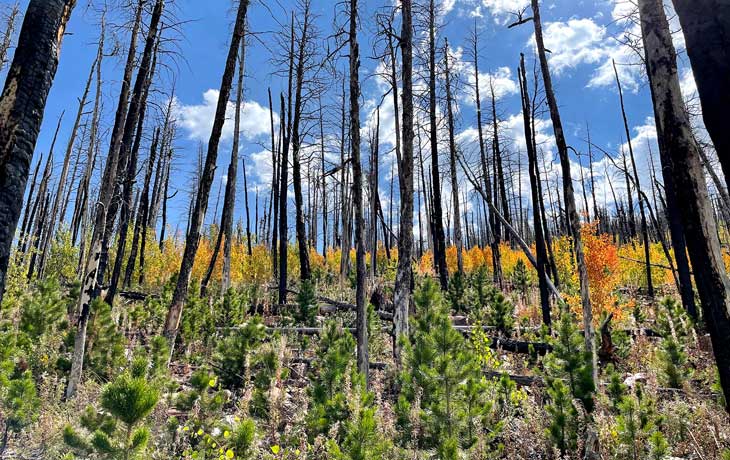
Nine years after the 2012 High Park Fire burned a stand of lodgepole pine that had been severely affected by the mountain pine beetle, lodgepole and aspen saplings were rebounding on this slope in the Arapaho and Roosevelt National Forests. Photo by Katie Nigro
A new study co-authored by Environmental Science, Policy, and Management professor Miranda Redmond suggests that forests in the western interior of the United States are not regenerating fast enough to keep pace with climate change, wildfires, insects, and disease.
As the climate becomes too warm for trees in certain places, tree ranges have been expected to shift toward more ideal conditions. However, analysis of national forest inventory data for more than 25,000 plots in the Western United States (excluding coastal states) found that tree ranges are generally contracting in response to climate change.
Results of the study, which was published in Nature Climate Change, show that trees not only fail to regenerate in the hottest, driest portions of their range but also fail to expand along the range’s cooler, wetter border. Katie Nigro, who led the study as a PhD student at Colorado State University’s Warner College of Natural Resources, said their results indicate that most tree species likely will not be able to move to more accommodating climates without assistance.
“Trees provide a lot of value to humans in terms of clean water, clean air, wildlife habitat, and recreation,” she said. "If forest managers want to keep certain trees on the landscape, our study shows where they can still exist or where they might need help.”
“These efforts are becoming increasingly critical due to the rapid pace and scale of tree die-offs from wildfires, drought, and other climate-driven disturbances, coupled with tree regeneration failures observed in many areas,” added Redmond, who served as Nigro’s PhD adviser while at Colorado State. Since joining UC Berkeley in 2023, Redmond’s lab has followed up on this research by studying tree species adaptations.
Read more about the study at Colorado State University.
This was adapted from material provided by Warner College of Natural Resources
